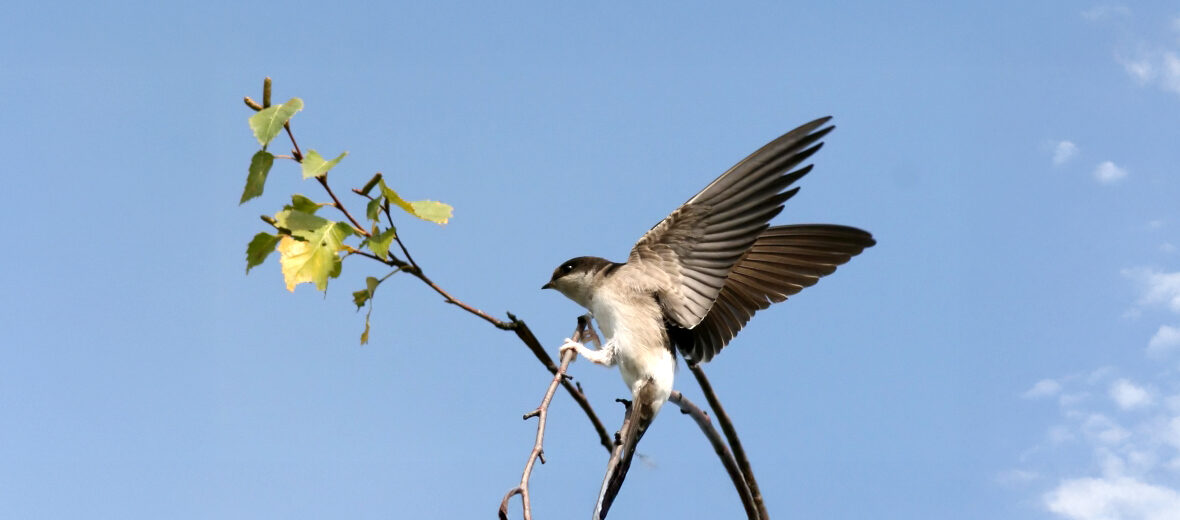
The western house martin, aka common house martin, northern house martin, or house martin, can be found throughout Europe, western Asia, and Africa. They are a passerine bird from the swallow family. These birds are threatened by invasive species, which can bring about predation and disease; and climate change, which can cause droughts, storms, and flooding. However, these avians are quite abundant and therefor listed as Least Concern by the IUCN. Their population trends are listed as stable.
First the Stats…
Scientific name: Delichon urbicum
Weight: Up to .65 ounce
Length: Up to 5 inches
Wingspan: Up to 11.5 inches
Lifespan: Up to 5+ years
Now on to the Facts!
1.) They were originally described by Carl Linnaeus in his 10th edition of Systema Naturae as Hirundo urbica, in 1758, but were later placed in their current genus, Delichon, by Thomas Horsfield and Frederic Moore in 1854.
2.) There are an estimated 80,200,000 wild individuals to date.
3.) Their general call is a soft twitter of melodious chirps. The contact call is a hard “chirrrp”, and their alarm is a shrill “tseep”.
4.) These birds prefer open countryside with low vegetation, like pastures, meadows, and farmlands preferably near water; although they’re also found in mountains up to at least 7,200 feet elevations.
5.) Western house martins prefer more urban settings than barn swallows.
But wait, there’s more on the western house martin!
6.) Originally a cliff and cave nester, with some cliff-nesting colonies still existing, with the nests built below an overhanging rock, they now largely use human structures such as bridges, buildings, and houses as nesting locations.
7.) The nest is a clean, closed, convex cup fixed below an appropriate ledge, with a small opening at the top.
Did you know…?
These martins can fly at speeds of up to 36 feet per second.
8.) Both the males and females take part in nest building from mud and line the interior with grass, feathers, and hair. The mud is collected from ponds, puddles, and streams.
9.) The nest opening is so small as to prevent swallows from entering the nest. Swallows tend to take over the martin’s nest. If successful, the martin will just relocate and rebuild a new nest.
10.) Nests are built colonially in groups of about 10, but nests of up to several thousand have been recorded.
But wait, there’s still more on the western house martin!
11.) Females lay up to 5 eggs that hatch in up to 16 days.
12.) The fledged chicks stay with, and are still fed by, the parents for up to a week after leaving the nest. Sometimes, 1st-year birds from the 1st brood will aid in feeding the 2nd brood.
Did you know…?
Fleas, mites, and mosquitoes, plus up to 29 other ectoparasites, plague the house martins externally, while Haemoproteus prognei which is transmitted by mosquitoes haunts them internally.
13.) Flies, flying ants, and aphids make up the bulk of their diet; and they typically hunt on the wing (in mid flight).
14.) The Eurasian hobby is their primary predator.
15.) Western house martins are mostly diurnal (active during the day), but they can also be crepuscular (active at dawn and dusk).
Now a Short Western House Martin Video!
Be sure to share & comment below! Also, check out the Critter Science YouTube channel. Videos added regularly!
Want to suggest a critter for me to write about? Let me know here.
Some source material acquired from: Wikipedia & IUCN
Photo credit: Ken Billington




